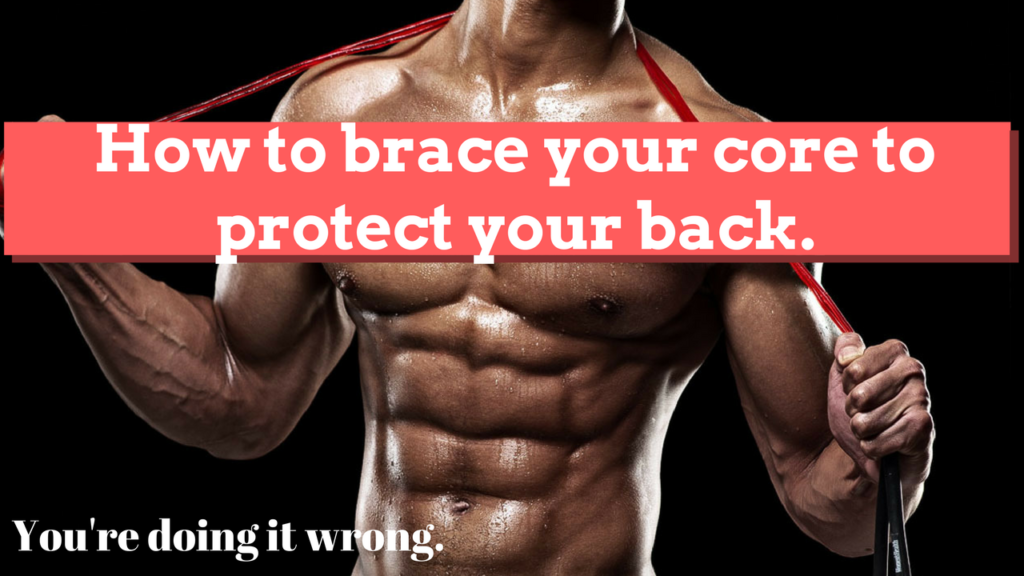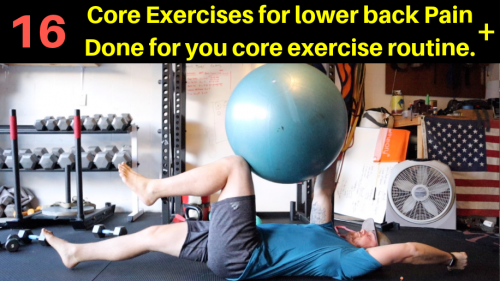
Listen up! It’s essential that you learn how to brace your core properly to prevent both future injury and back pain. Believe it or not there IS a right and a wrong way to brace the core and I want to share my techniques with you today! I will be covering not only how to brace your core to protect your lower back but when your “bracing” could be too much and actually causing you MORE pain.
So, I wanted to start off by first showing you a simple way to see if what you’re doing for “bracing” is sufficient enough to protect your lower back during daily activities and time in the gym. Proper bracing is paramount to protecting your lower back. You can hip hinge until your blue in the face but if your core isn’t braced properly, the protection you need isn’t there. This is why so many people still experience back pain while doing small things such as rolling over in bed or bending to grab their socks off the floor. Your spine needs stability, so brace it!
Let’s test to see if you’re able to brace your core properly before we start!
This is a critical step to make your time here on this article worth it. So I need 100% participation. To ensure that you actually take this test before starting I want to send the video to you myself.
Once you have established what a good brace and bad brace feels like, let’s now talk about how to apply this proper brace while we are standing and going through daily movements. Pairing the hip hinge with a proper brace is two of the most influential things you will ever do to protect your lower back.
A BIG MISTAKE with core bracing
Before we move on, I wanted to make a point that I wish someone would have told me years ago. A common issue I have seen over the years with clients is how they are bracing their core. You tend to get into the habit of doing this chest out, butt out, over extended posture to perform whatever activity you’re trying to do. This actually makes it super hard to brace your core properly which leaves you with a false sense of stability, overloading the lower back and facet joints.
This was me 100%. When I was deadlifting over 400lbs, this was my default position. Thinking about strategically bracing my core before a lift was an after thought. In my head, as long as I felt “tight” I was fine. A ruptured L5-S1 later proved me wrong. Getting away from the “duck butt” position and into a healthy core brace takes a little re-grooving of the body and mind but we will have you fixed in no time!
Moral of the story, focus on bracing. Make sure you’re doing it right even if that means tuning back the weight and making adjustments to your volume and frequency.
So you took the test…you passed or failed…now it’s time to fix what you have going on!
Can you Brace Your Core Too Much?
Absolutely! In fact I see more issues stemming from TOO MUCH bracing thenI do not bracing enough.
Think about it this way. Your body is super smart and was designed to be pretty self sufficient when it comes to activating and releasing muscles at certain times. Now after a surgery or during training there is a time where a proper core brace is critical to stabilizing the spine and rebuilding strength in the trunk.
With that being said, where core bracing goes wrong is when you have too much bracing going on!
IMO the number one culprit for this is trying to constantly obtain perfect posture. You have to give up trying to achieve perfect posture and adopt more variety in our postures. You walking around with your shoulders pulled back tight and your trunk always braced WILL develop bad habits and eventually cause symptoms that you will be chasing all over your body.
Constant muscle contraction is NOT how you improve posture and protect your spine.
One perfect example of this is having over tight QL’s.
No matter what you’re doing at home, at work or in the gym learn to brace your core. I can’t emphasize this enough! Without marrying these two things properly, you will be missing a key element to getting relief from your lower back pain.
Apply this to your own life. Think about what activities you do the most on a day-to-day basis that causes you lower back pain. Add these techniques to your mechanics before you complete that task and see how it makes a difference.
If this helped leave a comment below and let me know what activity you were doing when you tried it!
If it helped you I am confident it can help someone you know! Be sure to share the wealth with someone you know!
Talk to you soon
William
P.S
I have a free Core Exercise Crash Course where I share 16 Core Exercises for those with a sensitive back. I also show you how to program your own core workout using the exercises i give! Pick it up below!


One of the best videos I have come across while trying to understand really what bracing is!! Kudos to you sir !!
WOW thank you for those kind words! I am glad it helped you.
Hello
I love your website and all the information on there, plus the downloads are really interesting. I am a 59-year-old lady from the UK with degenerative discs in my spine, particularly lumbar, which causes agonising pain throughout my back, buttocks and legs (particularly right one). I have been on various painkillers (which I try to avoid), physio, injections, caudals, etc etc, all to no avail. I have also had breast cancer which obviously resulted in having aggressive chemotherapy, radiotherapy and medication for five years, I now have osteopenia and a lot of my health problems are linked to breast cancer treatment. Anyway, my surgeon has recommended spinal fusion, L4,L5,S1 and I am very worried, hence this email. I have tried to read up on it but the internet stories are frightening, mostly negative. I just wondered if you have had any contact with anyone who has been through the exact operation and can help in any way? I do have a 50% slip of L5 over S1 with narrowing of the spinal canal at that point and I have lost almost 3 inches in height. My hobbies all include movement – I love walking, dancing and gardening etc and I am terrified that I will become rigid after the op and no longer able to participate in my interests. I have to go back to see my surgeon in a few weeks and so I am trying to find out all I can in the meantime.
Thanks for anything you can offer.
Kind Regards
Jean.
Hey Jean,
I will always suggest you approach a more holistic way of healing back issues but some get to a point where you need more modern medicine for guidance. Fusions are not a death sentence they just come with more responsibility. Just as much as you did before, you have to really focus on learning how to use your body. People who are active like you move a lot yes, but they tend to move and use their body like junk. They don’t practice good spine hygiene and as they age small issues become big issues because they continue to look over the issues in their mechanics. This is not meant to discourage you but to encourage you to pursue a change in the way you use your body. How you bend, lift, sit and stand will have a direct impact on how you feel and how your body can heal.
Check out this article https://fitness4backpain.com/mri-scans-for-low-back-pain/
Hope this helps
William
Those two core-check videos will really help me. I had been doing the chest/butt out and wondered why mt back ached.
Thanks again,
Sandra
L4/L5 19 weeks ago
Bracing correctly makes all the difference! Keep practicing!